Juniper publishers Removal of the Power Line Interference from ECG Signal Using Different Adaptive Filter Algorithms and Cubic Spline Interpolation for Missing Data Points of ECG in Telecardiology System
Juniper Publishers Engineering Technology Open Access Journals
Removal of the Power Line Interference from ECG Signal Using Different Adaptive Filter Algorithms and Cubic Spline Interpolation for Missing Data Points of ECG in Telecardiology System
Authored by: Shekh Md Mahmudul Islam
Abstract
Maintaining one's health is a fundamental human right
although one billion people do not have access to quality healthcare
services. Telemedicine can help medical facilities reach their
previously inaccessible target community. The Telecardiology system
designed and implemented in this research work is based on the use of
local market electronics. In this research work we tested three
algorithms named as LMS (Least Mean Square), NLMS (Normalized Mean
Square), and RLS (Recursive Least Square). We have used 250 mV amplitude
ECG signal from MIT- BIH database, 25mV (10% of original ECG signal) of
random noise, white Gaussian noise and 100mV (40% of original ECG
signal) of 50 Hz power signal noise is added with ECG signal in
different combinations and Adaptive filter with three different
algorithms have been used to reduce the noise that is added during
transmission through the telemedicine system. Normalized mean square
error was calculated and our MATLAB simulation results suggest that RLS
performs better than other two algorithms to reduce the noise from ECG.
During analog transmission of ECG signal through existing
Telecommunication network some data points may be lost and we have
theoretically used Cubic Spline interpolation to regain missing data
points. We have taken 5000 data points of ECG Signal from MIT -BIH
database. The normalized mean square error was calculated for regaining
missing data points of the ECG signal and it was very less in all the
conditions. Cubic Spline Interpolation function on MATLAB platform could
be a good solution for regaining missing data points of original ECG
signal sent through our proposed Telecardiology system but practically
it may not be efficient one.
Keywords: Telemedicine; Power line interference (PLI); ECG; Adaptive filter; LMS; NLMS; RLSAbbreviations: EMG: Electromyography; ECG: Electrocardiogram; EEG: Electroencephalogram; NLMS: Normalized Least Mean Square; RLS: Recursive Least Square; SD: Storage Card
Introduction
The ECG signal measured with an electrocardiograph,
is a biomedical electrical signal occurring on the surface of the body
related to the contraction and relaxation of the heart. This signal
represents an extremely important measure for doctors as it provides
vital information about a patient cardiac condition and general health.
Generally the frequency band of the ECG signal is 0.05 to 100 Hz [1].
Inside the heart there is a specialized electrical conduction system
that ensures the heart to relax and contracts in a coordinated and
effective fashion. ECG recordings may have common artifacts with noise
caused by factors such as power line interference, external
electromagnetic field, random body movements, other biomedical signals
and respiration. Different types of digital filters may be used to
remove signal components from unwanted frequency ranges [2].
The Power line interference 50/60 Hz is the source of
interference in bio potential measurement and it corrupt the biomedical
signal's recordings such as Electrocardiogram (ECG),
Electroencephalogram (EEG) and Electromyography (EMG) which are
extremely important for the diagnosis of patients. It is hard to find
out the problem because the frequency range of ECG signal is nearly same
as the frequency of power line interference. The QRS complex is a
waveform which is most important in all ECG's waveforms and it comes
into view in usual and unusual signals in ECG [3].
As it is difficult to apply filters with fixed coefficients to reduce
biomedical signal noises because human behaviour is not exact depending
on time, an adaptive filtering technique is required to overcome the
problem. Adaptive filer is designed using different algorithms such as
least mean square (LMS), Normalized least mean square (NLMS), Recursive
least square (RLS) [4].
Least square algorithms aims at minimization of the sum of the squares
of the difference between the desired signal and model filter output
when new samples of the incoming signals are received at every
iteration, the solution for the least square problem can be computed in
recursive form resulting in the recursive least square algorithm. The
goal for ECG signal enhancement is to separate the valid signal
components from the undesired artifacts so as to present an ECG that
facilitates an easy and accurate interpretation.
The basic idea for adaptive filter is to predict the
amount of noise in the primary signal and then subtract noise from it.
In this research work a Telecardiology system has been designed and
implemented using instrumentation amplifier, band pass filter and
Arduino interfacing between Smartphone and Arduino board. First of all
raw ECG signal has been amplified and filtered by Band pass filter.
Analog signal has been digitized using Arduino board and then
interfacing between Arduino board and smart phone has been implemented
and Digitized value of analog signal has been sent from Arduino board to
smart phone and digitized value of analog signal has been stored in SD
storage card of smart phone. Using Bluetooth or existing
Telecommunication Network. As sinusoidal signals are known to be
corrupted during transmission it is expected that similarly an ECG
signal will be corrupted.
We have therefore designed an adaptive filter with
three different algorithms and simulated in MATLAB platform to compare
the performance of denoising of ECG signal. During transmission of ECG
signals through existing Telecommunication networks some data pints may
be lost. In this research work we have used cubic spline interpolation
to regain missing data points. If more data points are missing then
reconstruction of an ECG signal becomes impossible and doctor can not
accurately interpret a patient's ECG in an efficient manner. Cubic
spline interpolation has been implemented for various missing data
points of original ECG signal taken from MIT-BIH database. The
normalized mean square error of cubic spline interpolation was very low.
Cubic Spline interpolation in Matlab platform could be a better
solution for regaining missing data points of ECG signal theoretically.
Related Works and Literature Review
The extraction of high-resolution ECG signals from
recordings contaminated with system noise is an important issue to
investigate in Telecardiology system. The goal for ECG signal
enhancement is to separate the valid signal components from the
undesired artifacts, so as to present an ECG that facilitates easy and
accurate interpretation.
The work of this research paper is the development of
our previous research work "Denoising ECG Signal using Different
Adaptive Filter Algorithms and Cubic Spline Interpolation for Missing
data points of ECG in Telecardiology System” [5]. Many approaches have been reported in the literature to address ECG enhancement using adaptive filters [6-9],
which permit to detect time varying potentials and to track the dynamic
variations of the signals. In Md. Maniruzzaman et al [7,10,11]
proposed wavelet packet transform, Least-Mean-Square (LMS) normalized
least-mean-square (NLMS) and recursive-least-square (RLS), and the
results are compared with a conventional notch filter both in time and
frequency domain. In these papers, power line interference noise is
denoised by NLMS or LMS or RLS algorithms and performed by MTLAB or
LABVIEW. But in our research work we have developed our previous work.
We denoised ECG signal by removing power line interference, Random noise
and White Gaussian noise. In our previous research paper [12]
we denoised ECG signal from random noise and white Gaussian noise. In
our present research work we have added power line interference with
Pure ECG signal individually and added in mixed of power line
interference, random noise and white Gaussian noise in different
combinations. Finally in our research work we have used cubic spline
interpolation for regaining missing data points of ECG signal sent
through telecommunication network.
There are certain clinical applications of ECG signal
processing that require adaptive filters with large number of taps. In
such applications the conventional LMS algorithm is computationally
expensive to implement The LMS algorithm and NLMS (normalized LMS)
algorithm require few computations, and are, therefore, widely applied
for acoustic echo cancellers. However, there is a strong need to improve
the convergence speed of the LMS and NLMS algorithms. The RLS
(recursive least-squares) algorithm, whose convergence does not depend
on the input signal, is the fastest of all conventional adaptive
algorithms. The major drawback of the RLS algorithm is its large
computational cost. However, fast (small computational cost) RLS
algorithms have been studied recently In this paper we aim to obtain a
comparative study of faster algorithm by incorporating knowledge of the
room impulse response into the RLS algorithm. Unlike the NLMS and
projection algorithms, the RLS algorithm does not have a scalar step
size.
Therefore, the variation characteristics of an ECG
signal cannot be reflected directly in the RLS algorithm. Here, we study
the RLS algorithm from the viewpoint of the adaptive filter because
a. The RLS algorithm can be regarded as a special version of the adaptive filter and
b. Each parameter of the adaptive filter has physical meaning.
Computer simulations demonstrate that this algorithm
converges twice as fast as the conventional algorithm. These
characteristics may plays a vital role in biotelemetry, where extraction
of noise free ECG signal for efficient diagnosis and fast computations,
high data transfer rate are needed to avoid overlapping of pulses and
to resolve ambiguities. To the best of our knowledge, transform domain
has not been considered previously within the context of filtering
artifacts in ECG signals.
In this paper we compare the performances of LMS,
NLMS and RLS algorithms to remove the artifacts from ECG. This algorithm
enjoys less computational complexity and good filtering capability. To
study the performance of the algorithms to effectively remove the noise
from the ECG signal, we carried out simulations on MIT-BIH database.
During transmission of ECG signal through existing Telecommunication
network it may be corrupted or some data points may be lost. Linear
Spline interpolation was popular method for regaining missing data
points of ECG signal [13]. Cubic Spline interpolation has gained popularity very recently [6].
In our previous research work we used cubic spline interpolation. The
development of our previous research work i.e., in the present research
work, in this research paper we have also used cubic spline
interpolation for regaining missing data points of ECG signal sent
through telecommunication network.
Adaptive Filter Algorithms
In this research work a Telecardiology system has been implemented and proposed for sending ECG signal through smart phone (Figure 1).
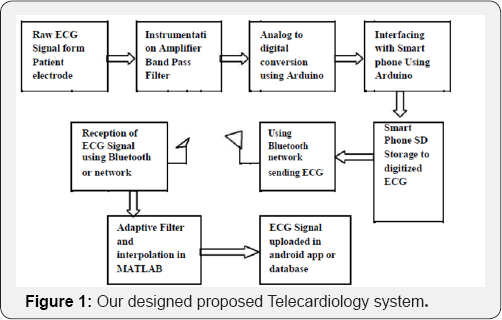
The raw ECG signal will be taken from patient
electrode and passed through instrumentation amplifier and band pass
filter to amplify the signal and to reduce the noise coming from
electrodes. Then that amplified and filtered analog ECG signal will be
converted into digital signal by using Arduino AVR microcontroller based
system. Then that digital value of ECG signal will be sent to smart
phone by using Arduino interfacing with smart phone and digitized signal
values will be sent to smart phone SD card. After that digital value
will be sent to another smart phone by using Bluetooth technology.
Digitized ECG value will be received to smart phone via Bluetooth
.During transmission of ECG signal through Telecommunication network it
may be corrupted by random noise or white Gaussian noise of the network.
Adaptive filter using different algorithms have been used to reduce
noise of the transmitted ECG signal. A MATLAB coding has been done to
reduce the noise of the ECG signal and for reducing noise of digitized
ECG signal, transmitted noisy ECG signal needs to be loaded in MATLAB
and then it is filtered suing adaptive filter with different algorithms
and performances of different algorithms are measured based on their
de-noising capabilities. During transmission of ECG signal some data
points may be missing and MATLAB spline interpolation algorithm will get
them back so that ECG signal can be transmitted reliably (Figure 2).
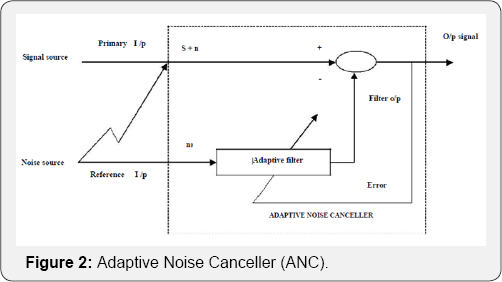
Least Mean Square (LMS), Normalized Mean Square
Algorithm (NLMS) and Recursive Least Square Algorithm (RLS) has been
designed and implemented for denoising ECG signal in MATLAB platform [4,12-14].
Cubic Spline Interpolation has been used for regaining missing data
points of ECG signal during transmission through existing
Telecommunication network. The normalized mean square error was
calculated for regaining missing data points of ECG signal and it was
very less and so Cubic spline interpolation could be a better solution
in MATLAB platform for regaining missing data points of ECG signal.
Result
In this work we have taken pure ECG signal from
MIT-BIH database. The amplitude of our taken ECG signal was 250 mV which
is amplified from.5mV (2 % of original ECG signal), 10 mV (4% of
original ECG) 15mV (6% of original ECG), 20 mV (8% of original ECG
signal) and 25mV (10% of original ECG signal) of random noise and white
Gaussian noise is added with ECG signal. Three different algorithms of
Adaptive filter were implemented and tested their performances of
denosing ECG signal. We have taken ECG signal with 250 mV amplitude and
5000 samples were taken from MIT-BIH database (Figure 3). In our simulation work we have denoised 100mV of 50 Hz power signal noise.
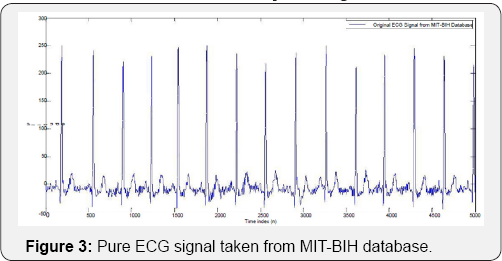
Least Mean square (LMS) Algorithms (Figure 4-7)
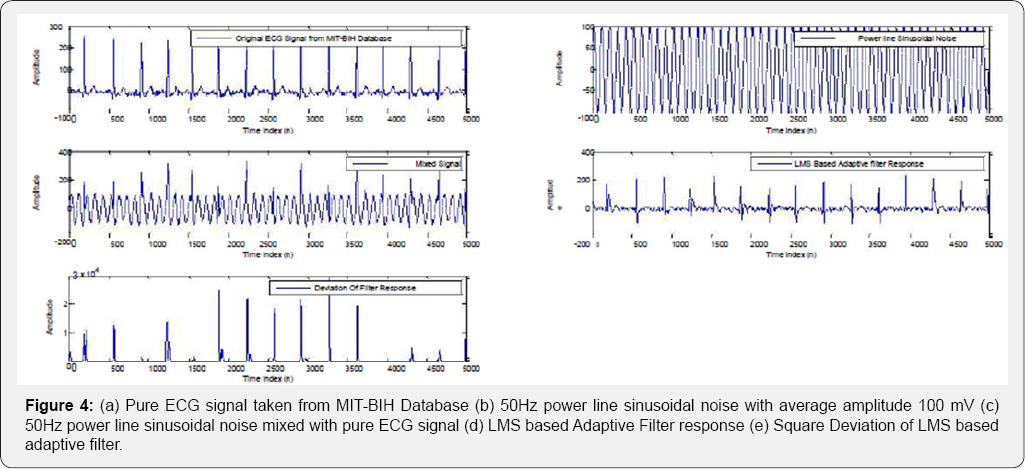
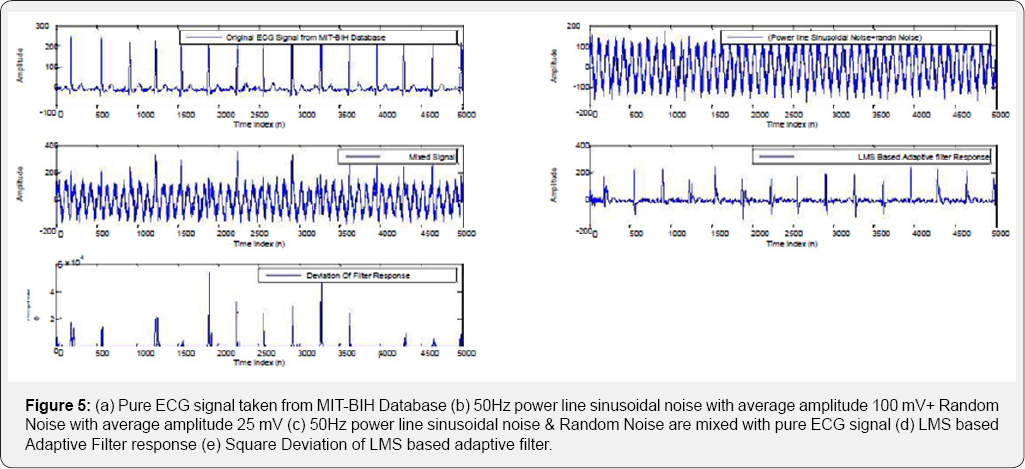
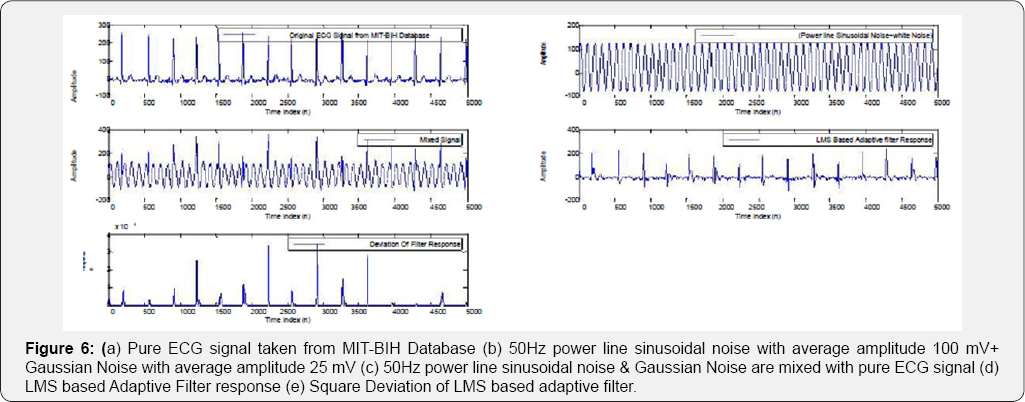

Normalized Mean Square (NLMS) Algorithms (Figure 8-11)

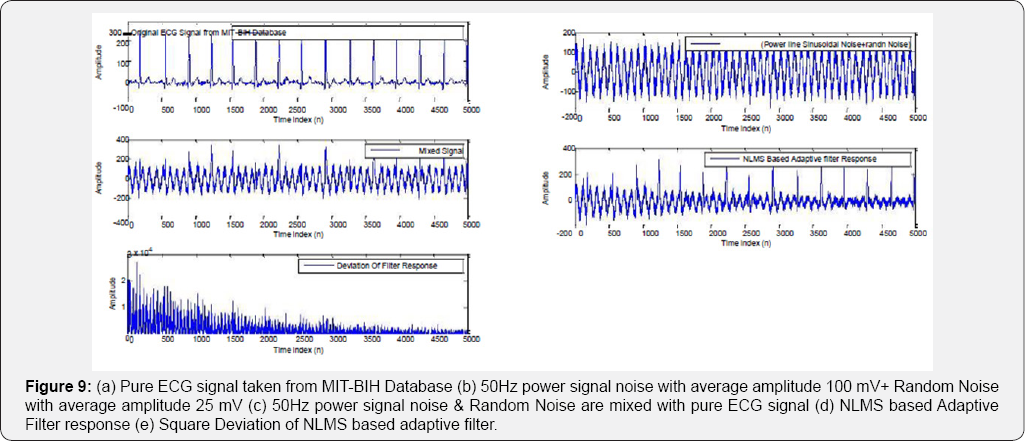
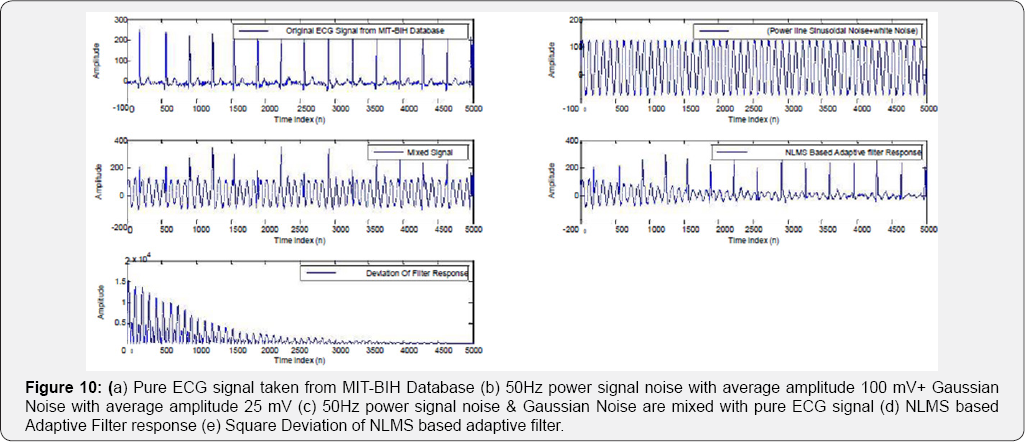

Recursive Least Square (RLS) Algorithms (Figure 12-14)

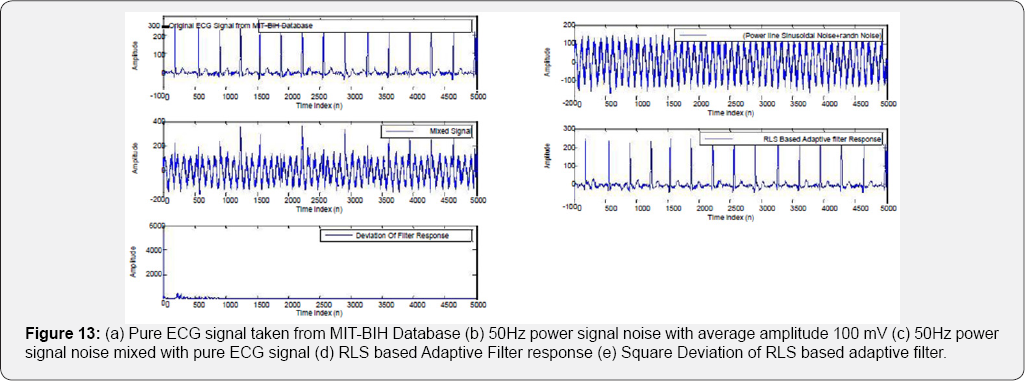
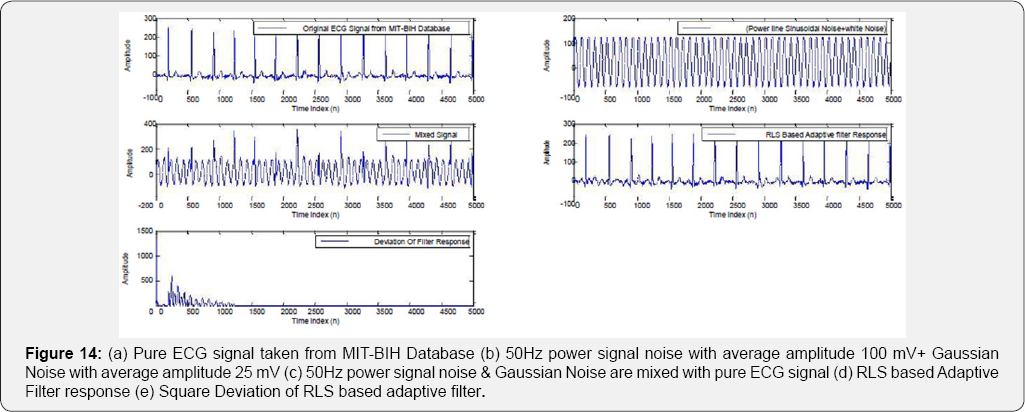
We have taken 5000 data points of ECG signal from
MIT- BIH database. In our simulation 11data points (from 689 to 699 of
original data points of ECG), 201 data points (from 800 to 1000 of
original data points of ECG), 300 data points (from 1600 to 1900 of
original data points of ECG), 500 data points (from 2000 to 5000) and 6
data points (from 4095 to 5000) are made zero and cubic spline
interpolation function was called in MATLAB platform and it could regain
the original data points of ECG signal (Figure 15-20). The MATLAB coding result of Spline Interpolation is given below Table 2
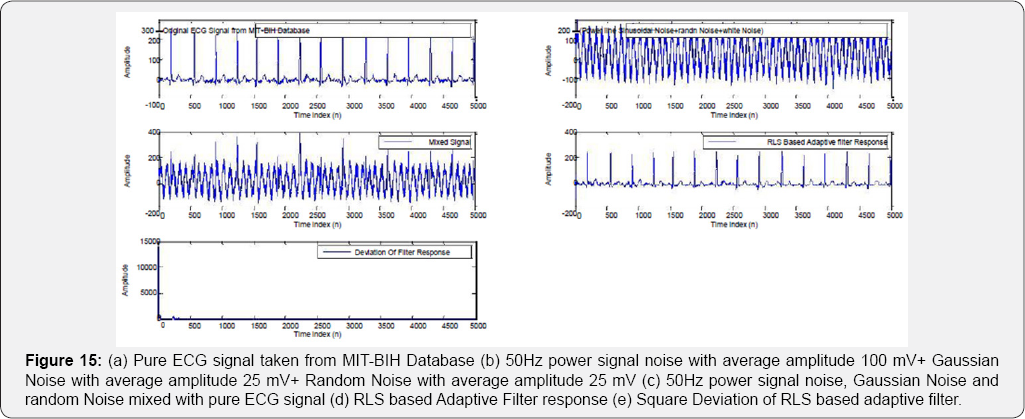
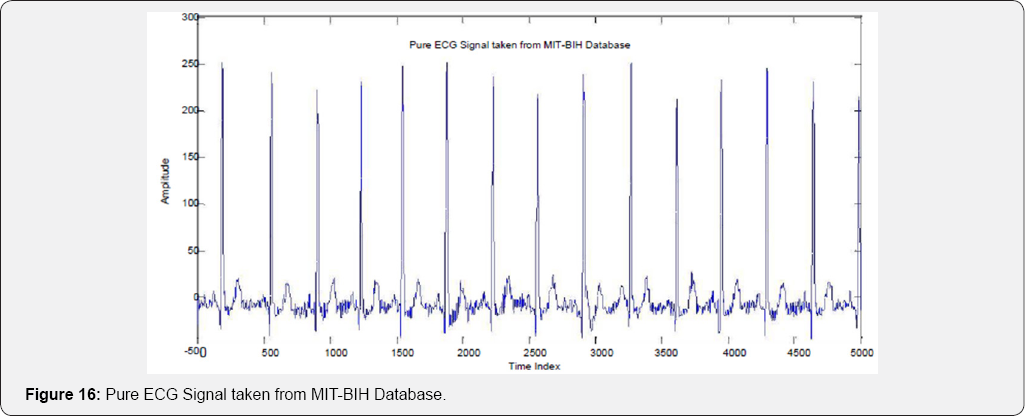

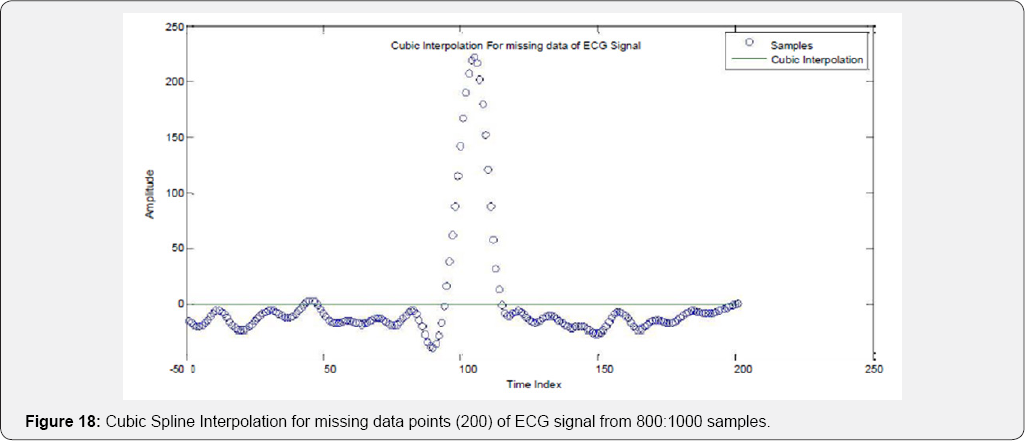
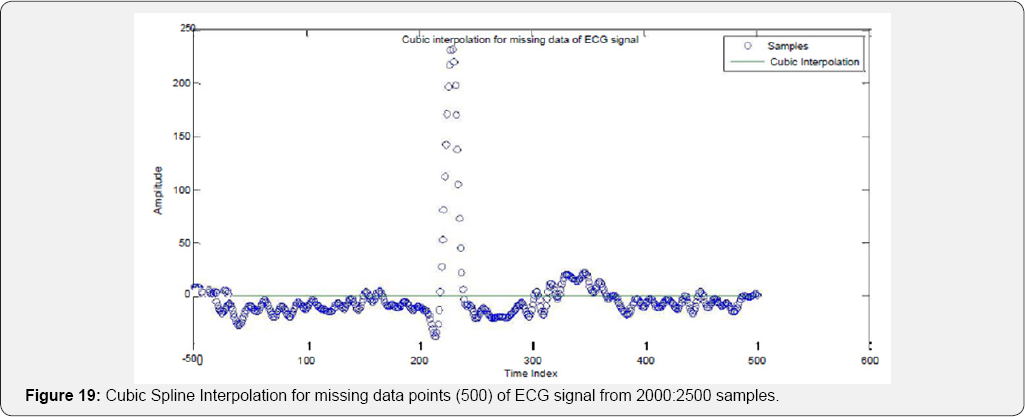
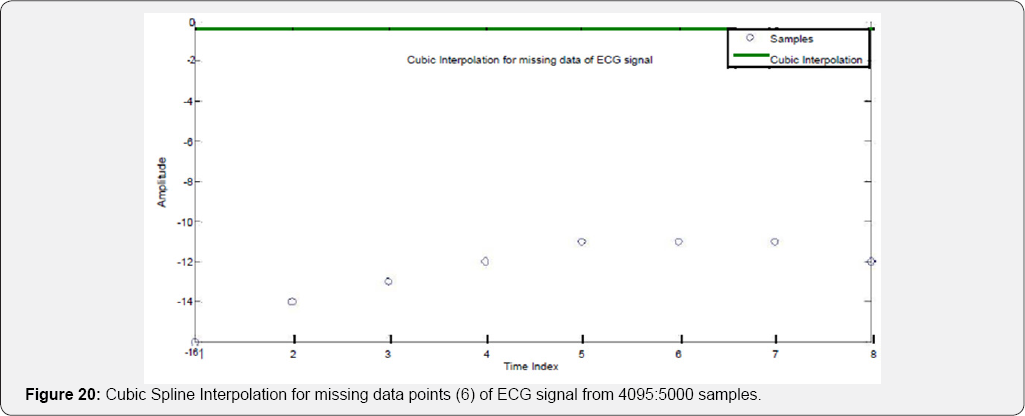
The above simulation result suggests that Recursive
algorithms. RLS could be the best option for Telemedicine system Least
Square algorithm (RLS) performs better than other two to denoise ECG
signal during transmission (Table 1).
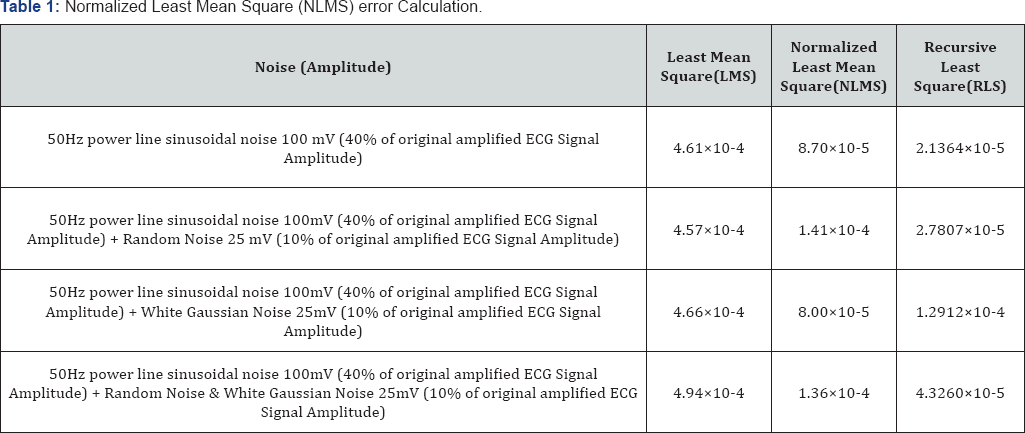

Normalized mean square error calculation suggests
that Cubic Spline performs satisfactorily for regaining missing data
points of ECG signal.
Conclusion
During transmission of ECG signal it may be corrupted
due to random noise and Gaussian noise. So we have tested the
performances of LMS, NLMS and RLS algorithm of adaptive filter. Our
simulation result suggest that RLS could be the best option for
recovering ECG signal or denoising EEG signal during transmission
through Telemedicine system.
https://juniperpublishers.com/etoaj/index.php
To read more...Fulltext please click on:
https://juniperpublishers.com/etoaj/ETOAJ.MS.ID.555555.php




Comments
Post a Comment